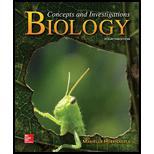
Concept explainers
A
a. sugar.
b. nitrogen-containing group.
c. sulfur-containing group.
d. phosphorus-containing group.
Introduction:
Nucleotides are defines as the organic molecules which serves as the building block of nucleic acid. It consists of phosphate group, pentose sugar and nitrogenous base. There are two types of nucleic acid such as ribonucleic acid and deoxyribonucleic acid. These are essential biomolecules responsible for forming all living forms on earth.
Answer to Problem 1MCQ
Correct answer:
The nucleotide is composed of phosphate group, pentose sugar and nitrogenous bases. Therefore, option (c) is correct.
Explanation of Solution
Reason for the correct statement
A nucleotide is organic molecule which is formed by phosphate group, pentose sugar and nitrogenous bases. There are two types of nitrogenous bases such as pyrimidine and purine bases. It also contain phosphate group. Deoxyribonucleic acid and Ribonucleic acid is formed by nucleotide. The only difference between in these two nucleic acid is presence of deoxyribose and ribose sugar as well as in RNA uracil is bonded with thymine while in DNA cytosine is bonded with thymine.
Option (c) is given as “sulfur-containing group”.
As, “Sulfur containing group is not found in nucleotide as it contains nitrogenous bases, phosphate group and sugar”, is the right answer.
Hence, option (c) is correct.
Reasons for the incorrect statements:
Option (a), is given as “sugar”.
There are two types of sugar is present in nucleotide as in RNA ribose sugar is present while in DNA deoxyribose sugar is present. Hence, it is a wrong answer.
Option (b), is given as “nitrogen-containing group”
Nitrogen-containing group are the nitrogenous bases which is of two types such as pyrimidine and purine. Hence, it is a wrong answer.
Option (d), is given as “phosphate-containing group”.
Nucleotide is formed by phosphate- sugar backbone along with that purine and pyrimidine bases are joined together by hydrogen bonds. Hence, it is a wrong answer.
Hence, options (a), (b), and (d), are incorrect.
Nucleotide is formed of sugar, phosphate group and nitrogenous bases and it do not contain sulfur containing group.
Want to see more full solutions like this?
Chapter 7 Solutions
Biology: Concepts and Investigations
Additional Science Textbook Solutions
Biological Science (6th Edition)
HUMAN ANATOMY
Campbell Essential Biology (7th Edition)
Biology: Life on Earth with Physiology (11th Edition)
SEELEY'S ANATOMY+PHYSIOLOGY
Genetics: From Genes to Genomes
- Selection of Traits What adaptations do scavengers have for locating and feeding on prey? What adaptations do predators have for capturing and consuming prey?arrow_forwardCompetition Between Species What natural processes limit populations from growing too large? What are some resources organisms can compete over in their natural habitat?arrow_forwardSpecies Interactions Explain how predators, prey and scavengers interact. Explain whether predators and scavengers are necessary or beneficial for an ecosystem.arrow_forward
- magine that you are conducting research on fruit type and seed dispersal. You submitted a paper to a peer-reviewed journal that addresses the factors that impact fruit type and seed dispersal mechanisms in plants of Central America. The editor of the journal communicates that your paper may be published if you make ‘minor revisions’ to the document. Describe two characteristics that you would expect in seeds that are dispersed by the wind. Contrast this with what you would expect for seeds that are gathered, buried or eaten by animals, and explain why they are different. (Editor’s note: Providing this information in your discussion will help readers to consider the significance of the research).arrow_forwardWhat is the difference between Uniporters, Symporters and Antiporters? Which of these are examples of active transport?arrow_forwardWhat are coupled transporters?arrow_forward
- How do histamine and prostaglandins help in the mobilization of leukocytes to an injury site? What are chemotactic factors? How do they affect inflammation process?arrow_forwardCompare and contrast neutrophils and macrophages. Describe two ways they are different and two ways they are similar.arrow_forwardDescribe the effects of three cytokines (not involved in the initial inflammation response). What cells release them?arrow_forward
 Concepts of BiologyBiologyISBN:9781938168116Author:Samantha Fowler, Rebecca Roush, James WisePublisher:OpenStax College
Concepts of BiologyBiologyISBN:9781938168116Author:Samantha Fowler, Rebecca Roush, James WisePublisher:OpenStax College
